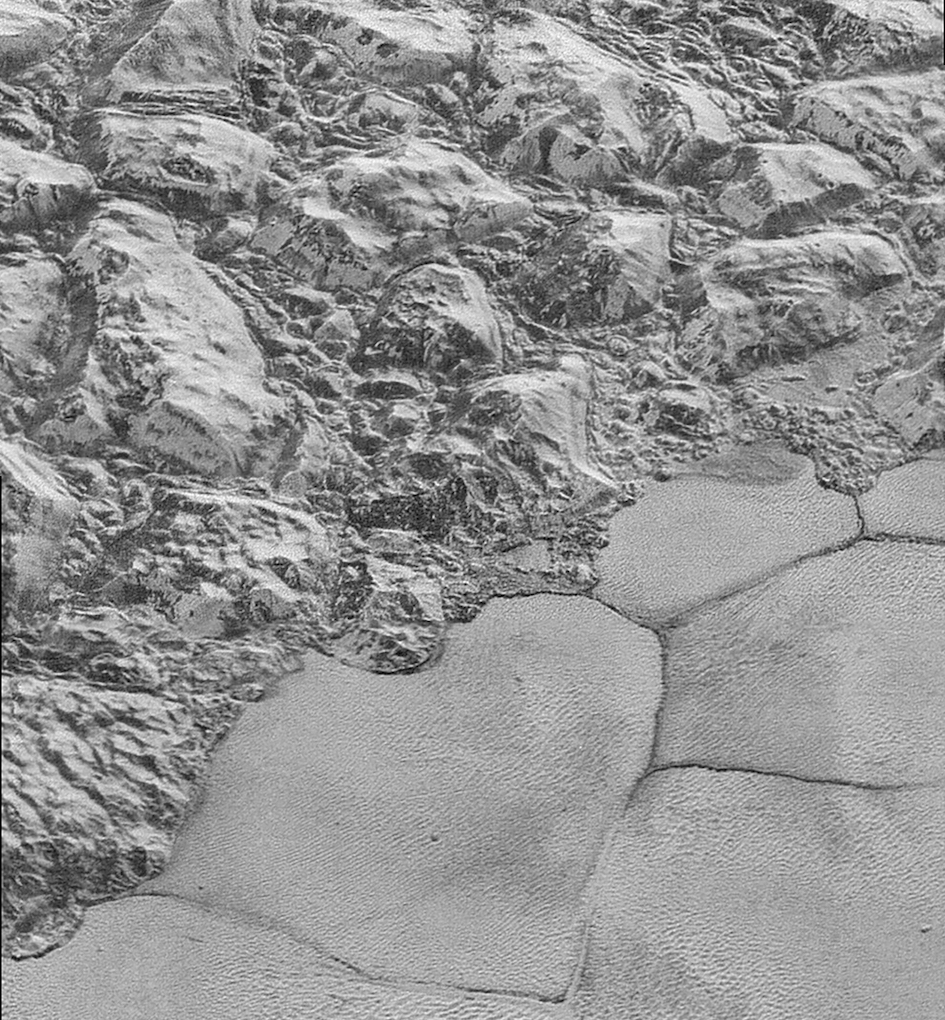
The New Horizons mission has already sent back phenomenal images and data from Pluto, but it keeps getting better. New images released today are the first in a series of the highest-resolution photos taken of Pluto’s surface during the flyby last July, showing mountains, glaciers, and craters in unprecedented detail.
“These close-up images, showing the diversity of terrain on Pluto, demonstrate the power of our robotic planetary explorers to return intriguing data to scientists back here on planet Earth,” said John Grunsfeld, former astronaut and associate administrator for NASA’s Science Mission Directorate. “New Horizons thrilled us during the July flyby with the first close images of Pluto, and as the spacecraft transmits the treasure trove of images in its onboard memory back to us, we continue to be amazed by what we see.”
These newest images have resolutions of about 250-280 feet (77-85 meters) per pixel, which show features smaller than half the size of a city block. The images form a strip 50 miles (80 kilometers) wide. They cover the surface from about 500 miles (800 kilometers) northwest of Sputnik Planum, cross the al-Idrisi mountains, and extend over the shoreline of Sputnik Planum. They were taken by the telescopic Long Range Reconnaissance Imager (LORRI) onboard New Horizons, about 15 minutes before closest approach to Pluto, from a range of just 10,000 miles (17,000 kilometers). While LORRI was snapping pictures every three seconds, the Ralph/Multispectral Visual Imaging Camera (MVIC) onboard New Horizons was also busy scanning the surface. Unusually short exposures were required to avoid blurriness in the images.
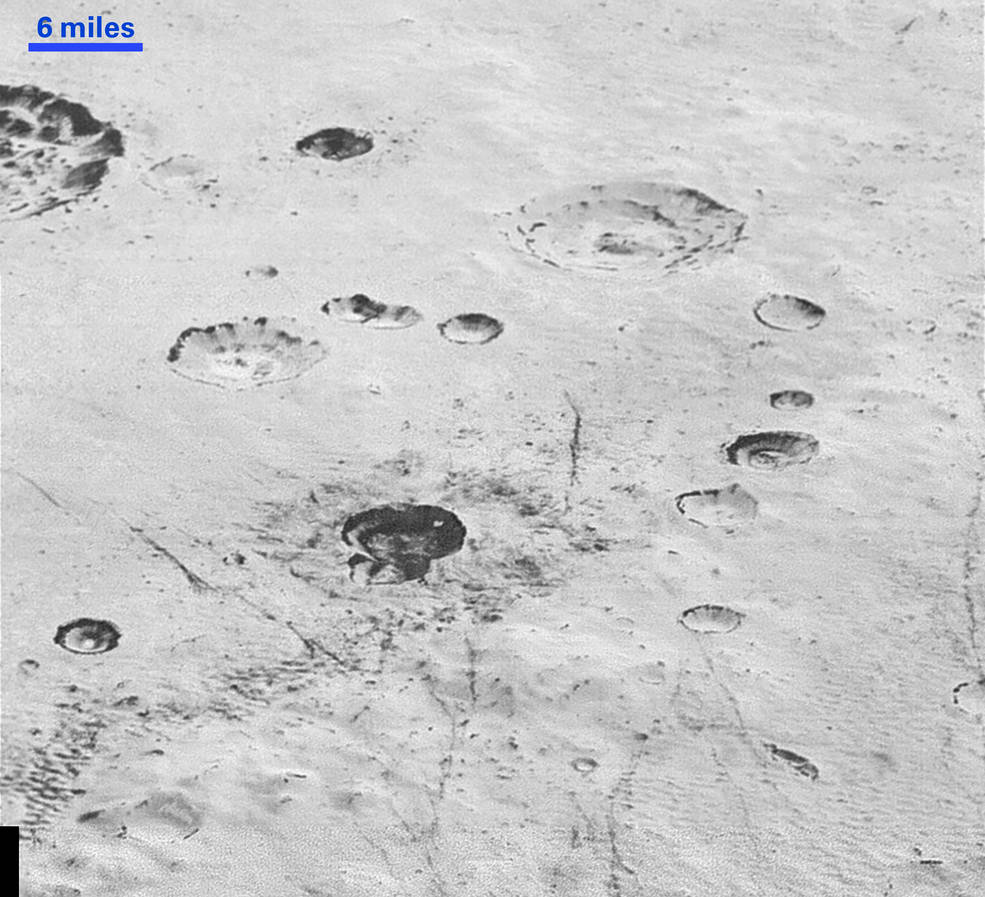
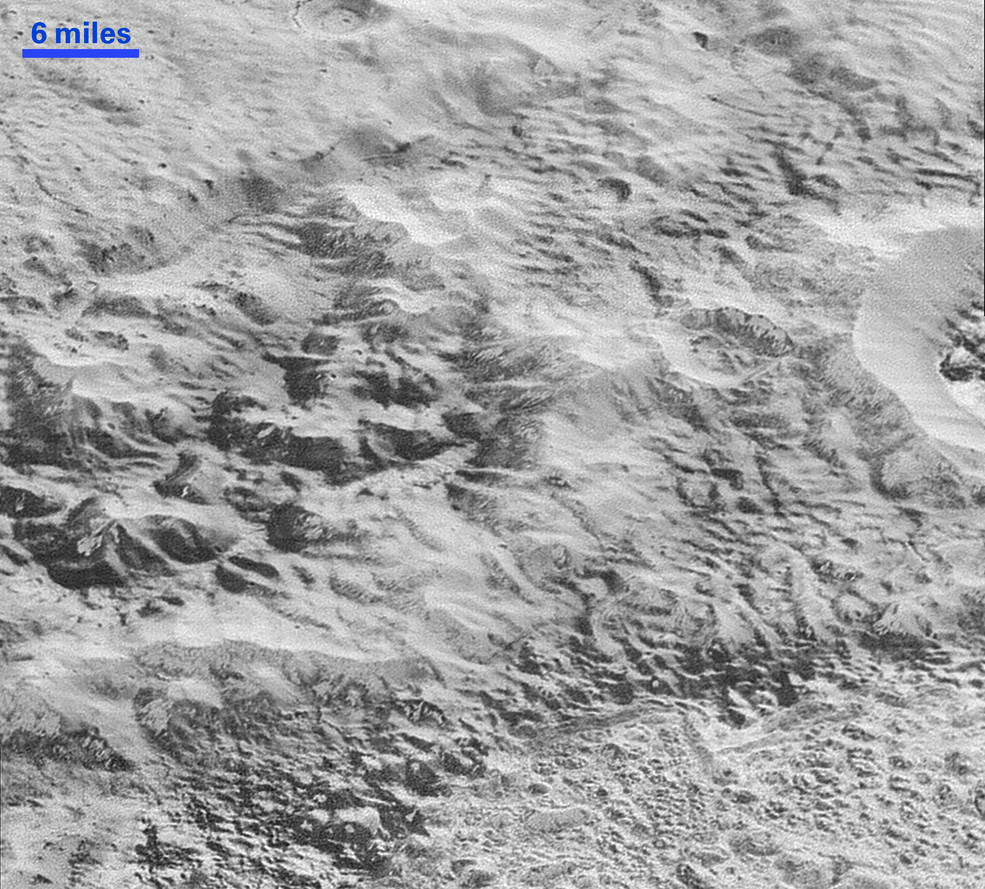
“These new images give us a breathtaking, super-high resolution window into Pluto’s geology,” said New Horizons Principal Investigator Alan Stern, of the Southwest Research Institute (SwRI) in Boulder, Colo. “Nothing of this quality was available for Venus or Mars until decades after their first flybys; yet at Pluto we’re there already – down among the craters, mountains and ice fields – less than five months after flyby! The science we can do with these images is simply unbelievable.”
“The mountains bordering Sputnik Planum are absolutely stunning at this resolution,” added New Horizons science team member John Spencer of the Southwest Research Institute.
The highest resolution version of the image strip can be seen here.
The images can also be viewed in this NASA video:
Even clearer evidence of geological processes can be seen in the newest images, including layering in some craters. It is not yet known if the layering is local, regional, or global. Dark linear features may be evidence of tectonics, according to mission scientists. There is a also a giant canyon system which stretches for hundreds of miles across the northern hemisphere.
“Impact craters are nature’s drill rigs, and the new, highest-resolution pictures of the bigger craters seem to show that Pluto’s icy crust, at least in places, is distinctly layered,” said William McKinnon, deputy lead of the New Horizons Geology, Geophysics and Imaging team, from Washington University in St. Louis.
The new images are six times better than the previous global map images taken by New Horizons, and five times better than the best images of Neptune’s largest moon Triton, taken by Voyager 2 in 1989. Before the flyby, it had been speculated that Triton might be very similar to Pluto, although the images and data have shown that Pluto is distinctly different, and really is a unique world.
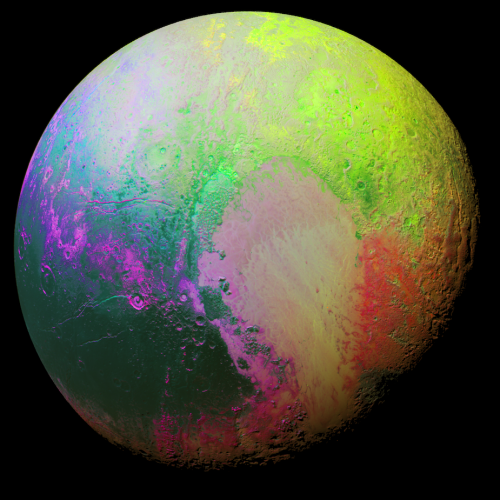
As previously reported on AmericaSpace, Pluto is a bizarre world, with complex geology, including possible ice volcanoes and oddly spinning moons. The two (so far) ice volcano candidates, Wright Mons and Piccard Mons, are tens of miles across and several miles tall. Wright Mons is located south of Sputnik Planum and is about 100 miles (160 kilometers) wide and 13,000 feet (4 kilometers) high. The summit depression is approximately 35 miles (56 kilometers) across, with a distinctive hummocky texture on its sides. The rim of the summit depression also shows concentric fracturing.
As noted by Oliver White, New Horizons postdoctoral researcher with NASA’s Ames Research Center, on Twitter, “If they really are volcanoes, it would be one of the most phenomenal discoveries of New Horizons.”
As for Pluto’s moons, they have been found to be spinning much faster than expected. The spin rates may be chaotic (variable) due to Charon, the largest moon, exerting a strong torque that prevents each small moon from settling down into synchronous rotation.
“Pluto’s moons are behaving like spinning tops,” noted co-investigator Mark Showalter of the SETI Institute in Mountain View, Calif.
It is also possible that there used to more moons than there are now. “We suspect from this that Pluto had more moons in the past, in the aftermath of the big impact that also created Charon,” said Showalter.
“The New Horizons mission has taken what we thought we knew about Pluto and turned it upside down,” said Jim Green, director of planetary science at NASA Headquarters in Washington. “It’s why we explore – to satisfy our innate curiosity and answer deeper questions about how we got here and what lies beyond the next horizon.”
New Horizons also recently took photos of another distant Kuiper Belt object, called 1994 JR1. The images were taken using the spacecraft’s Long Range Reconnaissance Imager (LORRI) camera. This rocky body is only about 90 miles (150 kilometers) wide and is currently 3.3 billion miles (5.3 billion kilometers) from the Sun, but only 170 million miles (280 million kilometers) away from New Horizons. This sets a new record for the closest-ever image of a small body in the Kuiper Belt.
Other images taken show both Pluto and its largest moon Charon in full rotation. Pluto’s days are really long at 6.4 Earth days. The images also show the difference between the “encounter side” of Pluto, seen in the highest resolution by New Horizons, and the “far side” seen in lower resolution. Charon’s day is also the equivalent of 6.4 Earth days, and like Pluto, the images show both the encounter and far sides of this moon.
There is even a cool new “psychedelic” view of Pluto in blazing false color. A technique called principal component analysis was used to highlight the many subtle color differences between Pluto’s distinct regions. The images used were taken by Ralph/MVIC color camera on July 14 at 11:11 AM UTC, from a range of 22,000 miles (35,000 kilometers).
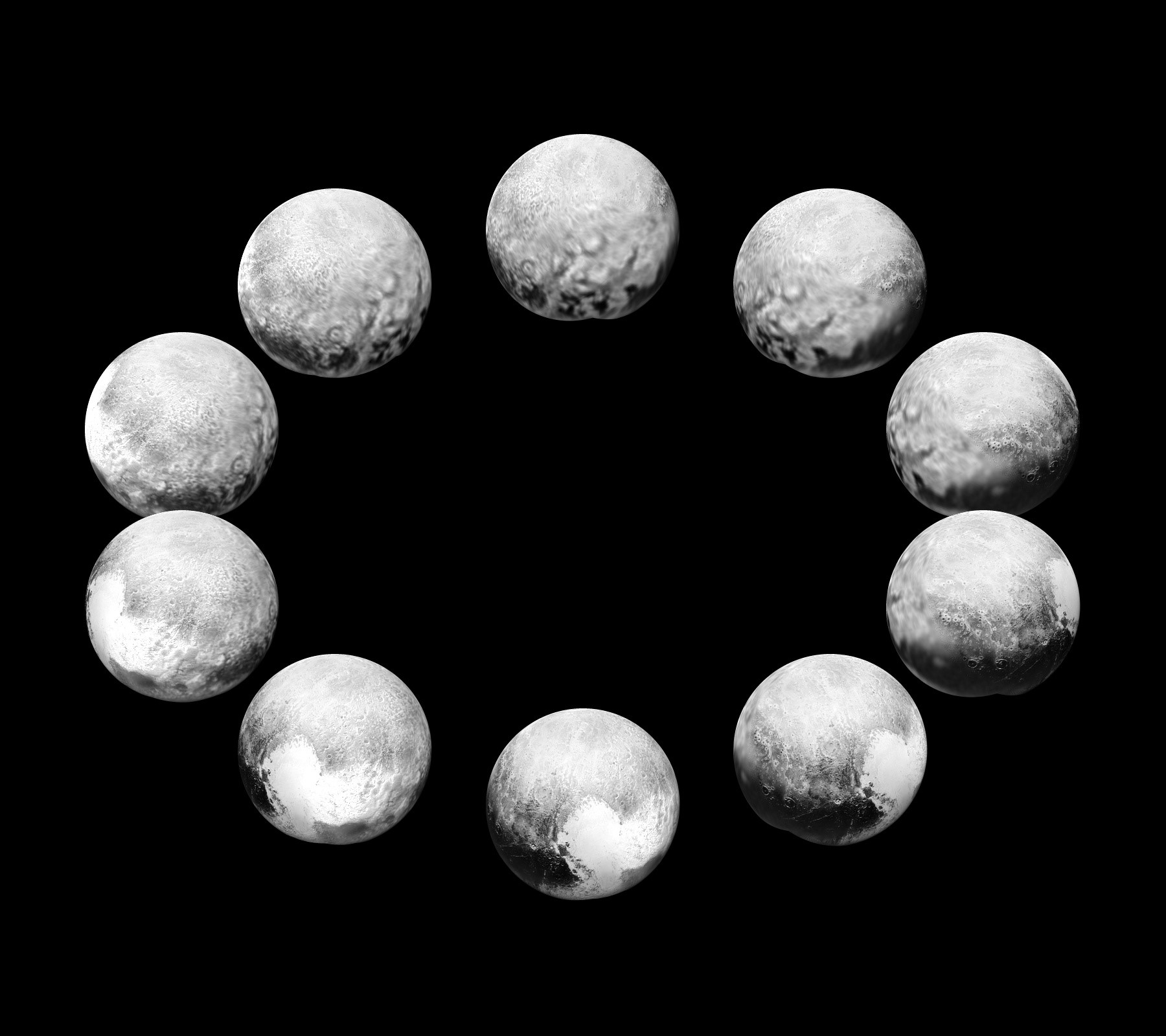
While the flyby may be long over now, there is still a lot to look forward to. Additional imagery from this strip will be released over the next several days, and the return of images and data in general is expected to take until next October to complete. Only about 25 percent of the total data from New Horizons has been sent back to Earth so far.
Until now, the best images of Pluto still only showed a fuzzy, tiny dot with very little detail. But now, we see its surface in incredible detail, and Pluto has become a real world. And an active world, at that.
“It’s hard to imagine how rapidly our view of Pluto and its moons are evolving as new data stream in each week. As the discoveries pour in from those data, Pluto is becoming a star of the Solar System,” said mission Principal Investigator Alan Stern of the Southwest Research Institute, Boulder, Colo. “Moreover, I’d wager that for most planetary scientists, any one or two of our latest major findings on one world would be considered astounding. To have them all is simply incredible.”
New Horizons is also still on course for its next encounter, with a smaller Kuiper Belt Object called 2014 MU69, on Jan. 1, 2019.
“Although this flyby probably won’t be as dramatic as the exploration of Pluto we just completed,” according to Stern, “it will be a record-setter for the most distant exploration of an object ever made.”
Follow our New Horizons mission page for regular updates.
Be sure to “Like” AmericaSpace on Facebook and follow us on Twitter: @AmericaSpace
.
Missions » New Horizons »




Thank you Paul Scott Anderson for the informative and lovely article!
“Moreover, I’d wager that for most planetary scientists, any one or two of our latest major findings on one world would be considered astounding. To have them all is simply incredible.”
For me, Pluto will always be the ninth planet.
And someday Pluto, with its many resources, will have human colonists and be a part of our active economic sphere.